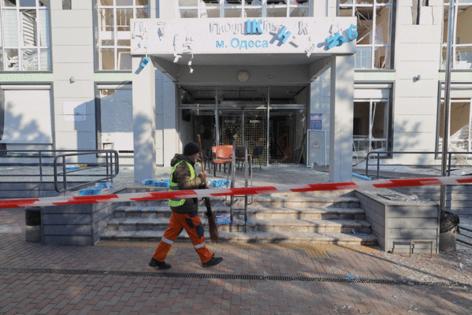Trump's Putin embrace could sour as US urges truce in Ukraine
Published in News & Features
Russian President Vladimir Putin’s unwillingness to countenance a temporary ceasefire in Ukraine is likely to be a key early test of the thaw in U.S. relations under President Donald Trump.
Officials in Moscow are cautious about Trump’s embrace of Putin, two people with knowledge of the situation said. The Russian leadership doesn’t fully understand the White House’s strategy and is wary of traps, another person close to the Kremlin said.
Russian Foreign Minister Sergei Lavrov said during a visit to Turkey Monday that while Moscow’s ready to negotiate for a peace deal, including with Ukraine and Europe, it’ll only stop fighting once there’s “a solid and durable result that suits Russia.”
With the war reaching its third full year on Monday, Russian forces are making grinding progress on the battlefield in Ukraine, at a huge cost in casualties. While Putin is ruling out a truce, Trump’s special envoy Steve Witkoff told CBS News Sunday that the U.S. is seeking a “temporary ceasefire” as a first step toward resolving the conflict. Witkoff said he met with Putin for about three-and-half hours earlier this month in Moscow.
“Trump’s charm offensive is seen positively, but there’s no wild enthusiasm either,” said Sergei Markov, a political consultant with close ties to the Kremlin. “We don’t see a solution to the Ukrainian crisis.”
Trump’s social media post last week labeling Ukrainian President Volodymyr Zelenskyy a “dictator” stunned Kremlin officials. Key members of the Trump administration declined to name Russia as the aggressor in the war at the weekend, while the U.S. is set to propose a United Nations resolution that fails to condemn Russia for the invasion.
The new U.S. administration has already said it’s unrealistic for Ukraine to gain back territory occupied by Russia and that the country won’t join the North Atlantic Treaty Organization. Trump has also endorsed calls for elections in Ukraine before a final peace deal is agreed, undermining Zelenskyy and aligning with Russian demands.
The rapid reversal in the U.S. approach to the war and relations with Russia is unfolding even as the Kremlin shows no sign of offering concessions or easing its military campaign. Hours after senior officials from Washington and Moscow met for talks in Saudi Arabia last week, Russia hit Odesa in Ukraine’s south with a massive drone strike that left 160,000 without power.
Trump’s rapprochement with Russia has fueled worries in Europe, which has largely been sidelined during early negotiations, about the future of the transatlantic alliance with the U.S.
Trump is pushing for a rapid end to the war, aiming to fulfill one of his main election campaign pledges. He has said he’s ready for a summit meeting with Putin, though no date has been agreed on yet.
The Trump administration told European officials that it wants to secure a ceasefire in Ukraine by Easter, which is in April, Bloomberg reported Feb. 16. To be sure, it’s unclear how insistent the Trump administration will be on an immediate ceasefire and whether Putin would risk walking away from negotiations over the issue.
The day after Trump’s diatribe against Zelenskyy, Treasury Secretary Scott Bessent said in a Bloomberg Television interview that the U.S. is prepared to either ramp up or ease sanctions based on Russia’s willingness to negotiate.
That revived threats by the U.S. leader to take aim at billions of dollars in Russian energy revenues that are fueling the war effort if the Kremlin doesn’t respond to his peace initiative.
Despite warm words after the Riyadh talks, which included discussion of economic opportunities for U.S. companies and an agreement to restore the functioning of embassies after years of drastic diplomatic cuts, the two sides remain at odds on how to end the war in Ukraine.
Trump has said he’d be supportive of European allies participating in a peacekeeping force and providing security guarantees for Ukraine, while ruling out a U.S. role. Russia insists it won’t accept NATO forces on Ukrainian territory and is also pushing to limit Kyiv’s military.
Russia occupies about 20% of Ukrainian territory, including Crimea which it seized in 2014, but doesn’t fully control the four regions in eastern and southern Ukraine that it annexed illegally after the full-scale invasion.
“For now, the prospect of a full-scale ‘deal’ looks unlikely: the U.S. and Russian positions are too far apart,” said Tatiana Stanovaya, founder of the R.Politik consultancy and a senior fellow at the Carnegie Russia Eurasia Center.
“Putin’s key goal remains a ‘friendly Ukraine,’ which is not about territorial divides or the security of the contact line, but about guarantees that Ukraine as a whole will turn away from the path of Western development,” she said.
©2025 Bloomberg L.P. Visit bloomberg.com. Distributed by Tribune Content Agency, LLC.







Comments